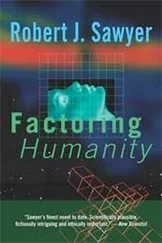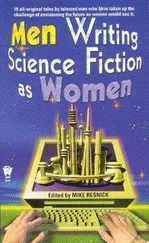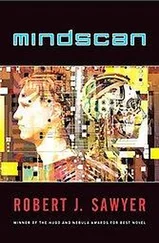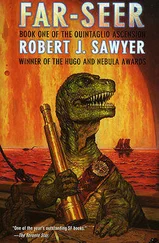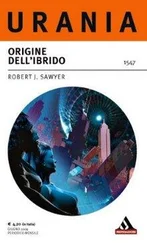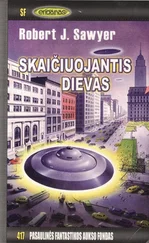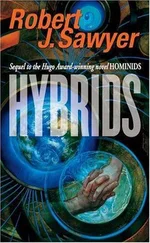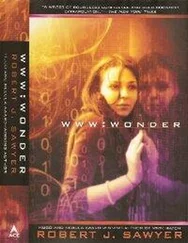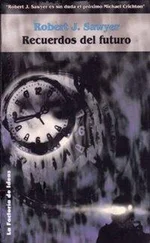Robert Sawyer - Calculating God
Здесь есть возможность читать онлайн «Robert Sawyer - Calculating God» весь текст электронной книги совершенно бесплатно (целиком полную версию без сокращений). В некоторых случаях можно слушать аудио, скачать через торрент в формате fb2 и присутствует краткое содержание. Город: New York, Год выпуска: 2000, Издательство: Tor Books, Жанр: Фантастика и фэнтези, на английском языке. Описание произведения, (предисловие) а так же отзывы посетителей доступны на портале библиотеки ЛибКат.
- Название:Calculating God
- Автор:
- Издательство:Tor Books
- Жанр:
- Год:2000
- Город:New York
- ISBN:нет данных
- Рейтинг книги:5 / 5. Голосов: 1
-
Избранное:Добавить в избранное
- Отзывы:
-
Ваша оценка:
- 100
- 1
- 2
- 3
- 4
- 5
Calculating God: краткое содержание, описание и аннотация
Предлагаем к чтению аннотацию, описание, краткое содержание или предисловие (зависит от того, что написал сам автор книги «Calculating God»). Если вы не нашли необходимую информацию о книге — напишите в комментариях, мы постараемся отыскать её.
Calculating God — читать онлайн бесплатно полную книгу (весь текст) целиком
Ниже представлен текст книги, разбитый по страницам. Система сохранения места последней прочитанной страницы, позволяет с удобством читать онлайн бесплатно книгу «Calculating God», без необходимости каждый раз заново искать на чём Вы остановились. Поставьте закладку, и сможете в любой момент перейти на страницу, на которой закончили чтение.
Интервал:
Закладка:
“Well, Mars is no older than Earth, and surely it was undergoing bombardment, too.”
“Oh, doubtless so,” said Hollus. “But although Mars clearly had running water in its past — its surface today is really quite impressive to stand upon; the erosion features are incredible — it never had large or deep oceans like those here on Earth. If an asteroid hits land, heat from the impact might raise temperatures for a matter of months. But if it hits water, which, after all, covers most of Earth’s surface now as well as billions of years ago, the heat would be retained, raising the planet’s temperature for decades or even centuries. Mars would have had a stable environment for the development of life perhaps as much as half a billion years before Earth did.”
“And then some of it was transferred here, on meteors?”
“Exactly. About one thirty-sixth of all the material that gets knocked off Mars by meteor impacts should eventually be swept up by Earth, and many forms of microbes can survive freezing. It neatly explains why full-fledged life is recorded in the oldest rocks here, even though the environment was too volatile for it to develop domestically.”
“Wow,” I said, well aware that my response wasn’t adequate. “I suppose one meteor with life on it might have made it here. After all, every lifeform on this planet shares a single common ancestor.”
Hollus sounded astonished. “All life on this planet shares one common ancestor?”
“Of course.”
“How do you know that?”
“We compare the genetic material of different lifeforms, and, judging by how much it diverges, we can tell how long ago they had an ancestor in common. For instance, you’ve seen Old George, the stuffed chimpanzee we have in the Budongo Rain Forest diorama?”
“Yes.”
“Well, humans and chimps differ genetically by only 1.4 percent.”
“If you will forgive me for saying so, it does not seem right to stuff and display so close a relative.”
“We don’t do that anymore,” I said. “That mount is more than eighty years old.” I decided not to mention the stuffed Australian aborigine they used to have on display at the American Museum of Natural History. “In fact, it’s largely through genetic studies that the concept of ape rights gained credence.”
“And such studies show all life on this planet to have a common ancestor?”
“Of course.”
“Incredible. On both Beta Hydri and Delta Pavonis, we believe there were multiple biogenerative events. Life on my world, for instance, arose at least six times during an initial 300-million-year period.” He paused. “What is the highest level in your hierarchical biological classification system?”
“Kingdom,” I said. “We generally recognize five: Animalia, Plantae, Fungi, Monera, and Protista.”
“Animalia are the animals? And Plantae the plants?”
“Yes.”
“All animals are grouped together? Likewise all plants?”
“Yes.”
“Fascinating.” His spherical torso bobbed deeply. “On my world, we have a level above that, consisting of the six — well, ‘domains’ might be an appropriate translation — the six domains from the six separate creation events; separate kinds of animals and plants exist in each. For instance, our pentapeds and octopeds are, in fact, completely unrelated; cladistic studies have demonstrated that they share no common ancestor.”
“Really? Still, you should be able to use the DNA technique I described to determine evolutionary relationships amongst members of the same domain.”
“The domains have commingled over the eons,” Hollus said. “The genome of my own species contains genetic material from all six domains.”
“How is that possible? As you said about Spock, the idea of members of different species — even from the same domain — having offspring is ludicrous.”
“We believe viruses played a substantial role over millions of years in moving genetic material across domain boundaries.”
I thought about that. It had been suggested on Earth that unnecessary material transferred into lifeforms by viruses accounted for much of the junk DNA — the ninety percent of the human genome that did not code for protein synthesis. And, of course, geneticists today were deliberately transferring cow genes into potatoes and so on.
“All six domains are based on DNA?” I asked.
“As I have said, every complex lifeform that we have discovered is based on DNA,” said Hollus. “But with DNA crossing domains throughout our history, the kind of comparative study you suggest is not something we have had much success with. Animals that are clearly very closely related, based on the gross details of body form, may have significant recent intrusions of new DNA from another domain, which would make the percentage of deviation between the two species deceptively large.”
“Interesting,” I said. A thought occurred to me, too crazy to voice out loud. If, as Hollus said, DNA was universally used in all lifeforms, and the genetic code was the same everywhere, and lifeforms even from different domains could incorporate each other’s DNA, then why couldn’t lifeforms from different worlds do the same thing?
Maybe Spock wasn’t so improbable after all.
18
It wasn’t yet Sunday night, but J. D. Ewell and Cooter Falsey visited the ROM anyway, to familiarize themselves with the museum’s layout.
“Nine dollars to get in!” exclaimed Falsey once they’d crossed through the Rotunda to the admissions desk, and he’d had a chance to consult the appropriate sign.
“They’re just Canadian dollars,” said Ewell. “It’s like a buck and a half U.S.” He reached into his wallet and pulled out two of the garish purple Canadian ten-dollar bills he’d gotten as change from his U.S. fifty for last night’s dinner at the Red Lobster. He gave them to the middle-aged woman behind the desk, and she handed him back a receipt, a two-toned two-dollar Canadian coin, and two rectangular plastic clips that said “ROM” on them, with a little crown above the central “O.” Ewell stared at them.
“You attach them to your shirt,” said the woman, helpfully. “They show you’ve paid.”
“Ah,” said Ewell, handing one to Falsey and clipping the other one on.
The woman gave them a glossy brochure. “Here’s a map of the galleries,” she said. “And there’s a coatroom over there.” She pointed to her right.
“Thank you kindly,” said Ewell.
They stepped forward. A dark-skinned man wearing a brown turban and a security officer’s blue blazer, white shirt, and red tie, was standing at the top of the four wide steps that led out of the Rotunda. “Where’s the Bogus Shale?” asked Ewell.
The guard smiled, as if Ewell had said something funny. “Back there; the entrance is by the coat check.”
Ewell nodded, but Falsey had continued going forward. Just ahead, two giant staircases rounded out onto this level, one on the left and one on the right. It was easy to see that each set of stone steps went up three floors, and the one on the right continued down into the basement. Each staircase encircled a huge totem pole of dark wood. Falsey had stopped by one of the totems and was staring up. The pole rose all the way to the ceiling and was topped by a carved eagle. The wood was devoid of paint, and had long vertical cracks in it.
“Will you look at that?” said Falsey.
Ewell glanced at it. Pagan symbols of a heathen people. “Come on,” he said.
The two walked back through the Rotunda. Next to the coat check was a set of open glass doors, with a carved-stone sign above them that said Garfield Weston Exhibition Hall; there were wheat sheaves on either side of the Weston name. Above this was a dark-blue fabric banner proclaiming in white letters:
Читать дальшеИнтервал:
Закладка:
Похожие книги на «Calculating God»
Представляем Вашему вниманию похожие книги на «Calculating God» списком для выбора. Мы отобрали схожую по названию и смыслу литературу в надежде предоставить читателям больше вариантов отыскать новые, интересные, ещё непрочитанные произведения.
Обсуждение, отзывы о книге «Calculating God» и просто собственные мнения читателей. Оставьте ваши комментарии, напишите, что Вы думаете о произведении, его смысле или главных героях. Укажите что конкретно понравилось, а что нет, и почему Вы так считаете.

